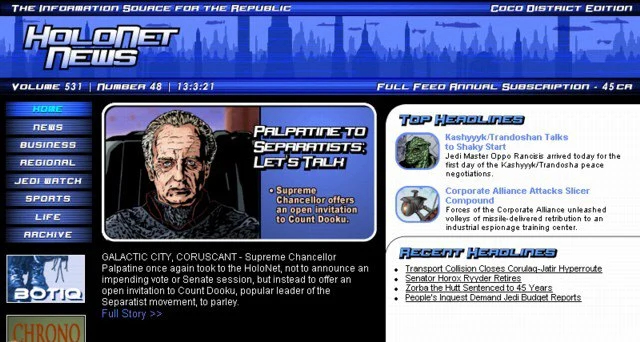From the moment Obi-Wan Kenobi mentioned The Clone Wars, fans such as myself wondered what exactly that entailed. What caused it? Who was doing the fighting? What role did Anakin Skywalker really play in them? Why the use of the plural and not the singular? The original Expanded Universe offered a few brief glimpses and clues, usually just enough to generate more questions than answers.
With the Prequel Trilogy launching in 1999, we were finally promised some real insights into what happened. The Phantom Menace didn’t go there, but as details emerged about Episode II it became clear that yes, we were finally going to see The Clone Wars in some respect and learn more about events that had to that point been more conjecture than reality.
Attack of the Clones, of course, starts off with a shocking event: The attempted assassination of Senator Padme Amidala of Naboo on a Coruscant landing platform. It wouldn’t be long in the movie before we learned Separatist forces were the likely culprit, but why were they immediately suspected? Also – and this is important – Who or what were the Separatists?
Those following along with updates to Starwars.com in the weeks leading up to Attack of the Clones’ release may have had a little better picture of what was going on and might have even anticipated the attempt on Amidala’s life. That’s because the site had been publishing updates from Holonet News.
The Holonet is something that has been mentioned on many occasions in Expanded Universe books and comics but is never referenced directly within any of the 10 Star Wars feature films, so you would be forgiven if you weren’t hip to what amounts to the official news distribution platform in a galaxy far, far away. It can best be understood as being akin to our own internet; not a media outlet of its own but a media technology used to send media across.
Holonet News, in the months prior to Attack of the Clones, sought to set the stage for what would happen in the movie, providing a bit of backstory to explain to the audience where the galaxy stood in the 10 years that had passed since the events of The Phantom Menace.

New installments were published more or less weekly between late-February and mid-May of 2002, right up to the release of the second Prequel installment. It featured updates on negotiations with the Separatists, technology news, information about Jedi movements across the galaxy and much more. There was even celebrity gossip and other “light” news.
The news on the site was written by well-known Star Wars author, curator and overall fan Pablo Hidalgo and TheForce.net co-founder Paul Ens, with illustrations by Lucasfilm illustrator and comics artist Joe Corroney. Most, but not all, the headlines appearing on the front page were clickable, offering full or partial stories.
What Holonet News did was add a few bits of important background information to the Star Wars Universe, which is something that’s always been lacking in the movies themselves. Most moves offer exposition and backstory through news clips seen in the background, radio broadcasts or newspaper clippings. “News,” though, is something that has never really been part of the Star Wars films. No one turns on the Holonet while they’re traveling between planets or preparing to make a smuggling run.
That’s partly because the characters we’re following – Luke, Rey, Obi-Wan, Han, Leia and everyone else – are usually too deep in the middle of what’s happening to really need an update on the news elsewhere.
The Holonet News effort came at a time before most movies were receiving significant online marketing efforts. It was only a few years after StarWars.com revolutionized movie marketing, first with clips from the 1997 Special Edition theatrical releases and then in the lead up to Episode I, when the site debuted first looks at the Naboo Starfighter and other new elements from the upcoming film. It would be five to six more years before movies like Cloverfield and The Dark Knight would receive immersive, cross-media ARG campaigns that upped the game on that front.
That’s not to say there weren’t innovative film campaign efforts in that time or that there haven’t been great ones since. Unfortunately even movies based on historical events or other true stories too often don’t provide more information on their subject matter that goes beyond a simple synopsis. Only occasionally are there websites that provide news clippings, full bios on the people whose stories are being told, or timelines that provide context for the movie.
In that way Holonet News offered something that was incredibly innovative at the time and still remains unique and exceptional. It gave Star Wars fans who were anxious to see what came next in the adventures of Padme, Anakin and Obi-Wan an on-ramp so that when we saw Padme’s ship explode, we had a better idea of the events that lead the characters to that moment.
Chris Thilk is a freelance writer and content strategist who lives in the Chicago suburbs.

